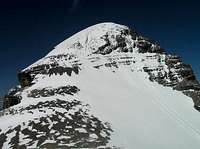-
 6671 Hits
6671 Hits
-
 72.08% Score
72.08% Score
-
 2 Votes
2 Votes
|
|
Route |
|---|---|
|
|
52.55071°N / 117.35512°W |
|
|
Mountaineering |
|
|
One to two days |
|
|
Alpine II (for full traverse) |
|
|
Overview
Mount Brazeau is an impressive mountain with several striking and formidable faces falling down to Maligne Lake and Coronet Creek in southern Jasper National Park. The West Face is massive and near vertical, rising nearly 1000 metres (3280 ft.) from Coronet Creek to the summit plateau, which is draped in the glacial mass of the Brazeau Icefield. The south and southwest slopes, topped with the Brazeau Icefield, are low angle and gentle, but are riddled with a minefield of hidden crevasses.Mount Brazeau is high on the list of Canadian Rockies 11,000 footers, depending on your perspective, either the thirteenth, seventeenth or twenty first highest mountain in the Canadian Rockies; 21 th on the generally accepted list of 54 summits. The summit reaches an impressive 3500 metres (11,483 ft.), based on the most recent National Topographic Map 1996 series.
Gaining the Brazeau Icefield is relatively easy and provides access to a beautiful glacier environment. The glacier is ideal for ski mountaineering and easy/moderate summer mountaineering.
Getting There
Jasper joins Banff National Park to the south via the Icefields Parkway. This parkway offers scenic driving, and more importantly, access to some of the best alpine and waterfall ice climbing in the world. The parking areas for all routes is at the Poboktan Creek trailhead, approximately 165 km north of the Trans Canada Highway or 70 km south the town of Jasper.Climbers are permitted to bivouac on long routes or otherwise where necessary to safely complete a climb. Some restrictions apply. A backcountry use permit is required, contact any Jasper National Park visitor centre, where you may obtain the permit.
Great bivy location for accessing the Brazeau Icefield, in the summer months, is located at NTS UTM grid reference 777179 (lat. 52.5103, long. -117.4749).
Route Description
Mount Brazeau, and the adjoining Valad Peak and Mt. Henry Macleod offer classic mountaineering objectives in summer or winter. As a ski mountaineering expedition, generally late winter or early spring will often the best snow conditions and stability. For summer mountaineering, typically mid June to the end of September offers the best conditions.- South Glacier (Normal Route), Alpine I
The relatively easy South and South-West slopes are simple glacier travel routes from the Brazeau Icefield and provide relatively easy ascents with proper snow and weather conditions. First ascended in 1923 by A. Carpe, W.D. Harris and Howard Palmer. An easy ascent usually from a high camp on the edge of the Brazeau Icefield. Descend the same route, often combined with a traverse of Valad Peak and Mt. Henry Macleod. Be prepared for the many crevasses and whiteout conditions; whiteouts are common atop this glacial plateau.
From the recommended bivy site, gain South-West toe of the Brazeau Icefield. This section has many crevasses; probing and careful route selection is required. Once on the flat glacier, I recommend heading to Mt. Brazeau first, and then traverse back towards camp via Valad, then Henry Macleod; this way you bag the primary summit first.
Travel glacier to south slopes of Mt. Brazeau. The snow/ice face does contain many loose rock sections and rock fall, and depending on snow conditions, potential for snow avalanches is significant. Climb with cool temperatures and early in the day.
Slopes generally low angle, 20 to 25 degrees, with a short section near top of 30 degrees; would be a cool ski descent. Summit easily reached from this slopes. Descend the same way.
Traverse to Valad Peak and Mt. Henry is straightforward and highly recommended. Simple snow climbing southward along ridge line.
Essential Gear
Climbing boots, crampons and helmet (mainly for South Glacier section on Brazeau). Standard glacier travel and crevasse rescue gear; depending on snow coverage, pickets or ice screws, pulleys, locking carabiners and carabiners, slings and prussiks. Probe is useful for detecting crevasses.If ski or winter mountaineering avalanche rescue gear is essential; beacon, probe and shovel.
High altitude camping gear for bivy camp. We had overnight temperatures of -22 C (10 F) in late June. Rain/snow storm shell, down jacket, waterproof climbing (ski) boots and good camp food.
External Links
Bill Corbett’s book, The 11,000ers of the Canadian Rockies, provides a comprehensive climber’s guide and history to the 54 11,000-foot peaks in the Canadian Rockies.11,000ers of the Canadian Rockies








